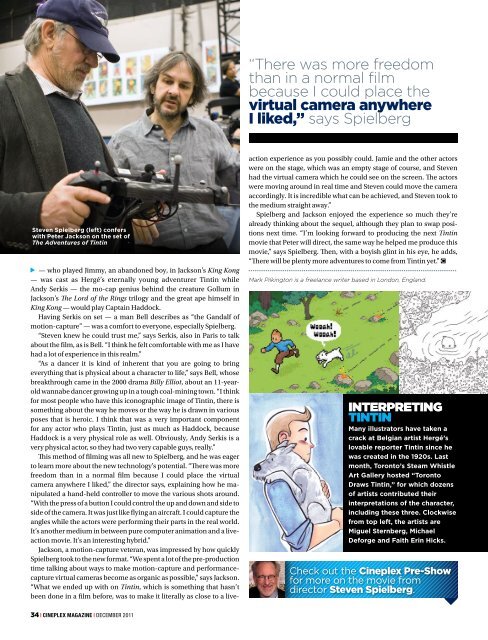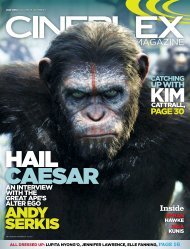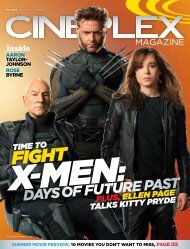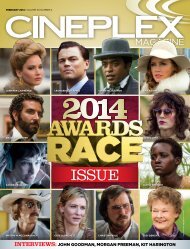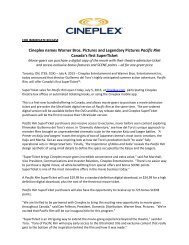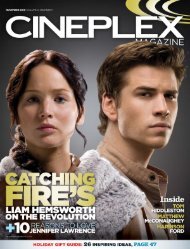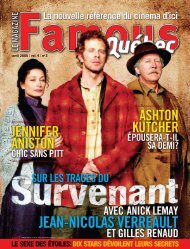Cineplex Magazine December2011
Cineplex Magazine December2011
Cineplex Magazine December2011
Create successful ePaper yourself
Turn your PDF publications into a flip-book with our unique Google optimized e-Paper software.
Steven Spielberg (left) confers<br />
with Peter Jackson on the set of<br />
The Adventures of Tintin<br />
— who played Jimmy, an abandoned boy, in Jackson’s King Kong<br />
— was cast as Hergé’s eternally young adventurer Tintin while<br />
Andy Serkis — the mo-cap genius behind the creature Gollum in<br />
Jackson’s The Lord of the Rings trilogy and the great ape himself in<br />
King Kong — would play Captain Haddock.<br />
Having Serkis on set — a man Bell describes as “the Gandalf of<br />
motion-capture” — was a comfort to everyone, especially Spielberg.<br />
“Steven knew he could trust me,” says Serkis, also in Paris to talk<br />
about the film, as is Bell. “I think he felt comfortable with me as I have<br />
had a lot of experience in this realm.”<br />
“As a dancer it is kind of inherent that you are going to bring<br />
everything that is physical about a character to life,” says Bell, whose<br />
breakthrough came in the 2000 drama Billy Elliot, about an 11-yearold<br />
wannabe dancer growing up in a tough coal-mining town. “I think<br />
for most people who have this iconographic image of Tintin, there is<br />
something about the way he moves or the way he is drawn in various<br />
poses that is heroic. I think that was a very important component<br />
for any actor who plays Tintin, just as much as Haddock, because<br />
Haddock is a very physical role as well. Obviously, Andy Serkis is a<br />
very physical actor, so they had two very capable guys, really.”<br />
This method of filming was all new to Spielberg, and he was eager<br />
to learn more about the new technology’s potential. “There was more<br />
freedom than in a normal film because I could place the virtual<br />
camera anywhere I liked,” the director says, explaining how he manipulated<br />
a hand-held controller to move the various shots around.<br />
“With the press of a button I could control the up and down and side to<br />
side of the camera. It was just like flying an aircraft. I could capture the<br />
angles while the actors were performing their parts in the real world.<br />
It’s another medium in between pure computer animation and a liveaction<br />
movie. It’s an interesting hybrid.”<br />
Jackson, a motion-capture veteran, was impressed by how quickly<br />
Spielberg took to the new format. “We spent a lot of the pre-production<br />
time talking about ways to make motion-capture and performancecapture<br />
virtual cameras become as organic as possible,” says Jackson.<br />
“What we ended up with on Tintin, which is something that hasn’t<br />
been done in a film before, was to make it literally as close to a live-<br />
34 | <strong>Cineplex</strong> <strong>Magazine</strong> | DECEMBER 2011<br />
“There was more freedom<br />
than in a normal film<br />
because I could place the<br />
virtual camera anywhere<br />
I liked,” says Spielberg<br />
action experience as you possibly could. Jamie and the other actors<br />
were on the stage, which was an empty stage of course, and Steven<br />
had the virtual camera which he could see on the screen. The actors<br />
were moving around in real time and Steven could move the camera<br />
accordingly. It is incredible what can be achieved, and Steven took to<br />
the medium straight away.”<br />
Spielberg and Jackson enjoyed the experience so much they’re<br />
already thinking about the sequel, although they plan to swap positions<br />
next time. “I’m looking forward to producing the next Tintin<br />
movie that Peter will direct, the same way he helped me produce this<br />
movie,” says Spielberg. Then, with a boyish glint in his eye, he adds,<br />
“There will be plenty more adventures to come from Tintin yet.”<br />
Mark Pilkington is a freelance writer based in London, England.<br />
inTerpreTing<br />
TinTin<br />
Many illustrators have taken a<br />
crack at Belgian artist Hergé’s<br />
lovable reporter Tintin since he<br />
was created in the 1920s. Last<br />
month, Toronto’s Steam Whistle<br />
Art Gallery hosted “Toronto<br />
Draws Tintin,” for which dozens<br />
of artists contributed their<br />
interpretations of the character,<br />
including these three. Clockwise<br />
from top left, the artists are<br />
Miguel Sternberg, Michael<br />
Deforge and Faith Erin Hicks.<br />
Check out the <strong>Cineplex</strong> Pre-Show<br />
for more on the movie from<br />
director Steven Spielberg.


